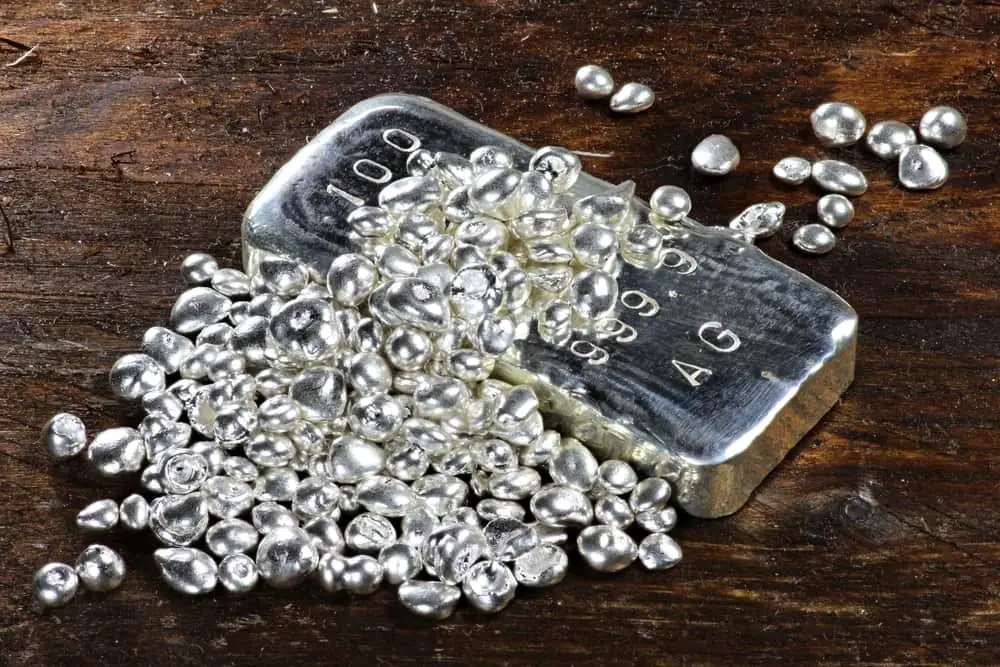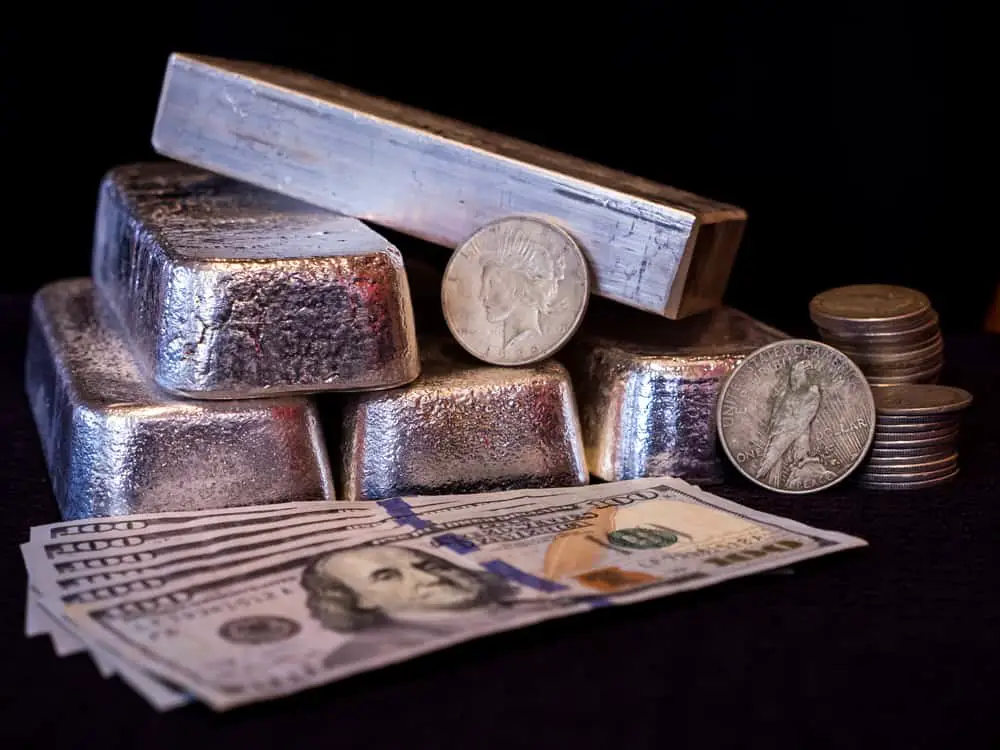Table of Contents
Humans have recognized precious metals as valuable for thousands of years. Archaeologists all around the world complete excavations filled with artifacts made of gold, silver, and other expensive materials because although civilizations rise and fall one thing remains the same: the rich and famous continue investing in gold and silver.
*This post may contain affiliate links. As an Amazon Associate we earn from qualifying purchases.
Learning how to invest in silver is taking part in an ancient tradition followed by kings, queens, and great warriors through the ages. Today, it comes with a modern twist and requires some background knowledge if you want to be profitable.
There are many ways and reasons to buy precious metals like silver. We’re going to bring you through everything you need to know here.
Why Silver?
If gold is for kings and silver is for gentlemen, then why not stick to gold?
Gold is valued for its use as currency, and it holds value as a result of it. While silver is also valued as a currency, it has other applications such as its use in industry. While there may come a point where gold is no longer tied to currency, and the gold standard fades into obscurity completely, silver will likely continue to have value long after.
Silver investing is a smart choice for many investors because even if you already hold stocks, bonds, and mutual funds, precious metals diversify and protect your portfolio.
How Silver Is Priced
Silver is treated differently in the markets than other precious metals, including and especially gold. Silver prices tend to swing with significant volatility because it has two uses to investors:
- Value of stored silver
- Value in silver used in industry
In other words, silver is traded as through it is being hoarded, but the supply and demand created by its role in the industrial supply chain play a big role in the price. The result is almost a tug of war between the two values that lead to significant fluctuations.
Because silver is used in industry, it’s also subject to changes caused by innovation and the growth of emerging economies. For example, silver is used in microcircuits and superconductors, making it a mainstay in technology manufacturing. As the middle class has grown in Asia, the demand for technology and electrical appliances also exploded, meaning silver became even more in demand.
More Importantly… Silver Is Cheaper than Gold
Gold is the most expensive of the precious metals on average, and buying gold usually requires a substantial initial investment. Because the price of silver swings as a result of its industrial uses, the market is seasonal, meaning it’s easier to buy it at its lowest yearly prices to make the most of your money.
Silver prices are up between January and May, but they begin to swing down from the annual price between June and December as a result of demand. While prices often bottom out in July and August, September through December offers a good time to buy and provides you a guide to bottom prices.
Volatility during the latter half of the year is one of the pros of buying silver: the entry price is low and getting into the market is simpler than buying gold.
Is Silver a Good Investment?
 Silver isn’t gold, and it never will be, but there are some unique qualities that make it a good investment. Of course, you need to balance these with the disadvantages of silver to better understand the risks.
Silver isn’t gold, and it never will be, but there are some unique qualities that make it a good investment. Of course, you need to balance these with the disadvantages of silver to better understand the risks.
Here’s what you need to know:
- The entry price is low.
The price point has been covered already, but it bears repeating because market entry often spooks potential precious metal buyers.
- Silver hasn’t reached the popularity of gold.
The gold market is saturated, but because silver isn’t as universally popular as gold, there’s still room in the markets for new investors.
- Silver offers multiple value drivers.
Again, silver is used as currency, but its uses in industrial applications mean it will hold its value.
- Primary silver mines are limited.
The limited number of mines combined with its use for industrial purposes means there could come a day where silver stocks run low, particularly if a new invention that demands a significant increase in silver production comes along.
- Silver is more liquid than other metals.
If the time ever arose where your physical purchases needed to be converted into real hard currency, you’d likely find it easier to trade silver over gold simply because the price is lower.
Of course, there are some things to consider before diving into a pit of silver coins.
Silver’s volatility requires level-headedness and a long-term strategy.
If you’re buying physical silver, then you need greater amounts of storage. Because bars are worth less, you’ll need more bars to invest a greater amount of money. If storage costs are a concern, then this is a factor to think about.
Silver’s use in the industrial market is impacted by the economy. In the event of an economic crisis, the price may hit the floor and struggle to get back up again.
How to Make Your First Silver Trade
Ready to make your first silver investment? We’re here to walk you through the steps.
1. Establish Trading Goals
Before you even think about opening a trading account, you need to figure out what your goals are.
- Why are you buying silver in the first place?
- What do you how to achieve?
- In gold vs silver investment decisions, what do you hope to gain by purchasing silver that you can’t achieve with gold?
Once you answer these questions, you’ll have a better idea of your strategy: investing or trading.
2. Choose Long-Term Investing vs. Short Term Trading
How and what you buy is determined by your strategy. When you’re looking at precious metals, you’re usually thinking about one of two strategies: investing in metals over the long-term or trading in the short-term.
Investing implies that you’re willing to put your money in silver and then let it sit and gain value while naturally taking a few hits along the way as a result of the volatility of silver.
Trading implies a more proactive approach where you attempt to buy and sell as prices change to profit.
Either method generates profits, but it might not fit your goals. Moreover, precious metals are better suited to long-term investments. If you’re going to buy in, it’s worth holding onto the asset for at least three years before considering selling it off.
If you’re not sure what to do, refer back to your investing goals.
Are you buying silver to protect your wealth? Or are you buying silver to speculate on prices and potentially make some money? The answer to these questions will point you in the direction of an appropriate strategy.
3. Choose Your Format: Coins and Bars or Paper Silver?
 When buying precious metals, purists encourage purchasing the metal itself. Why? Because it’s the most direct form of investment in precious metals and while the price is affected by economic events, it’s not as reliant on the economy as ETFs or equities in mining companies.
When buying precious metals, purists encourage purchasing the metal itself. Why? Because it’s the most direct form of investment in precious metals and while the price is affected by economic events, it’s not as reliant on the economy as ETFs or equities in mining companies.
Silver comes in bars and coins and can be purchased from dealers at home and abroad. These bars are available in many sizes and weights, and coins range in size and price depending on the nation using them.
Whether you buy bars or coins depends in part on where your interest lies and in part on your strategy: coins are more liquid than bars and are easier to trade.
One of the benefits of choosing bars or coins is in your ability to buy at either a premium or discount compared to the market price of the metal. Coins and bars may have their own price tied into their popularity and thus are priced according to the price of silver as well as the supply and demand of the physical shape itself.
But the overall benefit of buying physical metals? Hard assets offer security you can’t find on the markets.
If you’re not keen on the idea of physical silver and thrive on the drama of trading on the market, futures, options, or ETFs are your investment vehicle. ETFS are also more convenient if you already have a broker or market account, and they prevent you from needing to deal with step four – finding a reputable dealer.
Trading silver futures contracts happens on precious metals exchanges. These contracts are similar to stock futures: two parties agree on a contract to buy or sell silver on a precise date for a set price. You also have the opportunity to buy options on silver futures, which allow but don’t obligate you to purchase silver at a price.
ETFs (exchanged-traded funds) are traded on the stock market. If you’re into silver investing, you will look towards the SLV, the iShares Silver Trust ETF, which is the silver pricing ETF. But you’re not limited to SLV; there are plenty of other ETFs to choose from including:
- SIVR
- USV
- DBS
- AGQ
- ZSL
- USLV
- DSLV
- SIL
- SLVP
If you’ve chosen to go the ETF route, you’ll also need to learn more about silver pricing, both the history and futures pricing with a focus on silver spot pricing, which determines the cost of an ETF. However, exchange transactions are generally cheaper than physical purchases. Commissions are smaller and the contracts require fewer resources for storage and insurance and shipping and handling.
4. Find a Reputable Metals Dealer
If you’ve chosen physical silver as your silver investing tool to secure your wealth and diversity your portfolio, then you need to find a reputable dealer or broker. For some, identifying a dealer is the trickiest part of buying silver.
First, if you’re buying silver coins, you can’t just buy any old coin. Rare and collector’s coins don’t offer the same value as silver bullion, but many new investors don’t find that out until they’ve got a case of commemorative semi-numismatic coins, which are priced highly by dealers but are impossible to sell.
To find a reputable dealer, you’ll need to arm yourself with knowledge of:
- Spot prices
- Differences between bullion and other silver products
- Individual dealers buy-back policies
Once you know what to buy and can differentiate good prices from poor ones, you’ll be equipped to sift through the customer service aspect of buying silver. Look for dealers who allow you to take possession quickly either because they’re local or offer fast, trustworthy shipping.
Don’t forget to make sure all the costs are included, so you don’t end up paying more than you imagined in shipping, insurance, commission, and bank fees.
Get in On Silver’s Share of the World’s Wealth
Whether you’re buying precious metals to secure your existing wealth, future-proof your investments, or try your hand at trading on the stock market, silver is a great choice.
Silver investing offers a lower barrier to entry than gold while also promising a level of security and value in the long-term that make buying silver worth it. Not only has no one ever defaulted on silver – especially physical silver – but it has long-term use as money if you’re sceptical about the future of the treasury.

